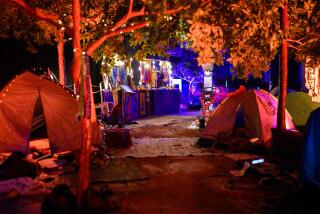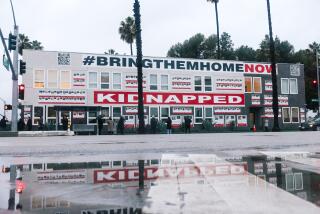Shock as a Work of Art : Documentary Exhibit Captures Navy’s Tailhook Scandal With Stark Physical Reminders
Two years after it jolted America and tarnished the Navy’s reputation, Tailhook still has the power to shock.
“The feeling I got was just so much more sadness, anger and frustration,” Jackie LaBouff, a 57-year-old Torrance resident, said after viewing a documentary exhibit this week at Cal State Dominguez Hills in Carson.
The exhibit, titled “Ritual and Sacrifice at Tailhook ‘91,” details the alleged sexual assaults on female officers two years ago during the Las Vegas convention of naval and Marine fighter pilots.
“Looking at the exhibit made (me) scared, then angry,” said one viewer, who along with others was asked to leave written comments in a notebook.
“The truth will prevail and this exhibit is a giant step in that direction,” wrote another viewer, Madonna Newburg. “The ‘boys’ cannot be excused for their animal behavior,” she said.
The exhibit, conceived by Frances Pohl, an art history professor at Pomona College, can best be described as an “art installation,” or assemblage. It pairs enlarged excerpts of a U.S. inspector general’s office report on Tailhook with physical reminders of the assaults--a torn blouse, a paint-smeared handprint, a pile of broken glass, a replica of a penis-shaped rubber object from which some women reportedly were forced to drink.
The shards of glass accompany a portion of the report that describes an incident in which a young woman outside the hotel was hit by a falling window. According to the report, the woman suffered a concussion when “mooning” male aviators pressed their bare buttocks so hard against the hotel window that it broke away from the building and fell, striking the woman on the head and shattering glass around her.
The handprint accompanies an excerpt about an incident in which an officer reportedly smeared the chemical substance from a broken Chemlight onto a naked, 17-year-old girl. And a carpet square, soiled and stained by Pohl and her group of artistic helpers, is juxtaposed next to an excerpt about how the Tailhook convention hotel had to replace carpets left reeking with vomit, urine and beer.
Tailhook T-shirts also form part of the exhibit, emblazoned with such slogans as “Women are Property--He-Man Woman Haters Club.”
The exhibit, scheduled to remain on view through 7 p.m. today in the women’s center at Cal State Dominguez Hills, was first shown at the 1993 Tailhook convention held last month in San Diego. It was staged by the Los Angeles chapter of Women’s Action Coalition, a national activist and feminist group organized after the Anita Hill-Clarence Thomas hearings to focus attention on sexual harassment.
After the San Diego convention, the exhibit was shown in Pomona and then moved and reassembled this week at Cal State Dominguez Hills. Plans are being made to keep the exhibit intact and offer it to other groups and universities that have expressed interest in it.
By using the official government text as a framework, Pohl says, she unintentionally gave the exhibit a sense of authenticity it might otherwise have lacked. The presence of the black and white text and many black and white photographs also conveys a documentary feeling.
“I guess since I had read the report so many times, I had almost become immune to the violence in it,” Pohl said. “When I read the comments (left by viewers) it reminds me of what a powerful exhibit it is.”
Likewise, the absence of human faces in the exhibit conveys the inhumanity of the alleged sexual assaults, in which women were reportedly grabbed, disrobed and fondled by dozens of male aviators as the women tried to make their way through hotel corridors.
The only face in the exhibition is that on a larger-than-life photograph of Lt. Paula Coughlin, the female officer who brought the Tailhook assaults to light and agreed to testify in public about the attack she suffered. (Last month, the government dropped criminal charges against the man Coughlin identified as her primary attacker after three defense witnesses testified that he was not the man who had assaulted her.)
Others pictured in the exhibit’s photographs, in most cases naked men, have no faces. The pictures are copies of photographs from the government report on Tailhook, in which the faces were blacked out.
Pohl said she took pains not to put anything in the exhibit that could leave it open to charges of obscenity. The precautions, apparently, did nothing to diminish the exhibit’s impact on those who viewed it.
Said Gabriel Silva of Anaheim, a 32-year-old fine arts major at Cal State Dominguez Hills: “I . . . feel guilty and ashamed.”
More to Read
Sign up for Essential California
The most important California stories and recommendations in your inbox every morning.
You may occasionally receive promotional content from the Los Angeles Times.










